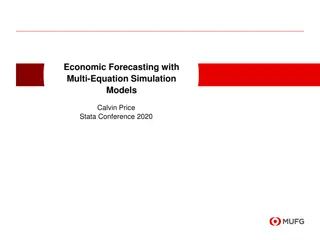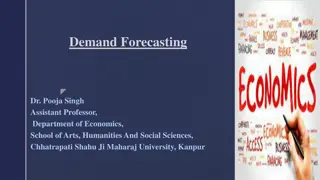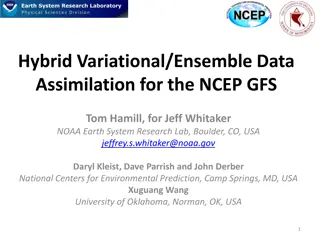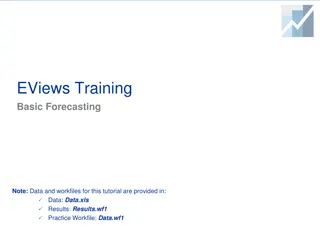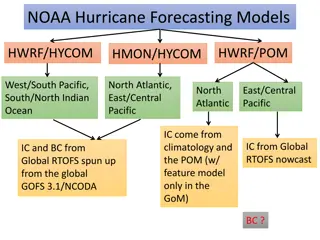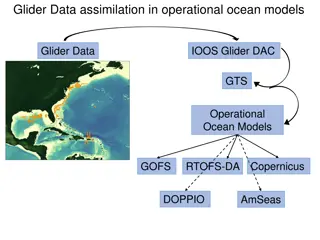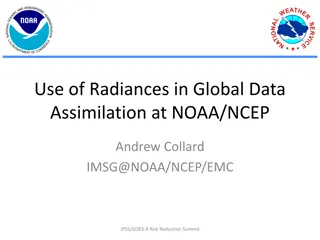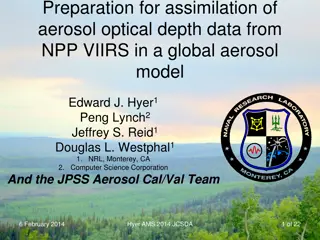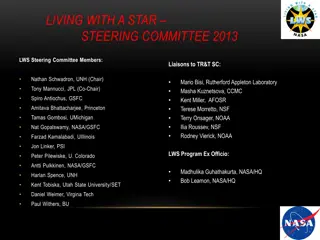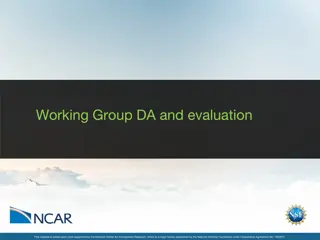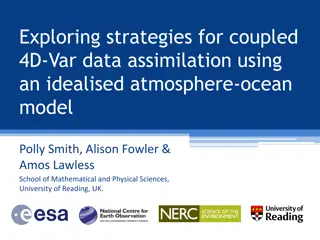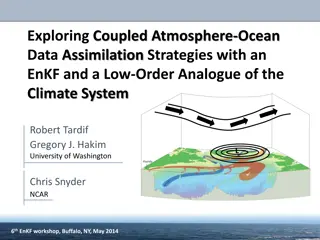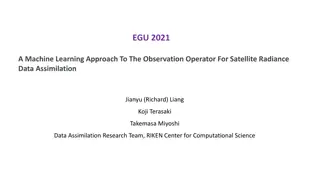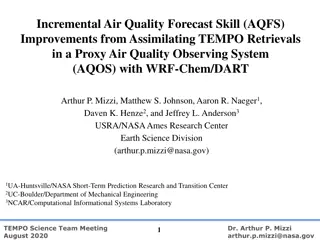Advances in Operational Air Quality Forecasting and Data Assimilation
Key observations and advancements in operational air quality forecasting and data assimilation were highlighted in sessions featuring prominent experts from various organizations like ECMWF/CAMS, GAFIS, NOAA, and ECCC. Topics discussed ranged from progress and challenges in air quality forecasting in Europe to the development of next-generation air quality and aerosol predictions. The move towards online integrated NWP-AQ systems, the importance of timely delivery and established evaluation protocols, as well as efforts to improve collective capability for vegetation fire and smoke pollution forecasts were emphasized. Machine learning applications, ensemble forecasting, and advancements in data assimilation techniques were also explored, showcasing the continuous evolution and enhancement of air quality prediction models.
Download Presentation

Please find below an Image/Link to download the presentation.
The content on the website is provided AS IS for your information and personal use only. It may not be sold, licensed, or shared on other websites without obtaining consent from the author. Download presentation by click this link. If you encounter any issues during the download, it is possible that the publisher has removed the file from their server.
E N D
Presentation Transcript
Concluding remarks some selected personal observations of Sessions 1,3 & 6 (only) Johannes Flemming (ECMWF/CAMS & GAFIS)
Session1. Operational Air Quality Forecasting: Progress and Challenges Radenko Pavlovic - Overview of the ECCC Operational AQ Forecasting Program: Status, Recent Improvements, and Perspectives Ivanka Stajner- Development of NOAA s Next Generation Air Quality and Aerosol predictions Vincent-Henri Peuch -Progress and Challenges with Air Quality Forecasting in Europe Li Zhang Development and Evaluation of the Aerosol Forecast Member in NCEP s Global Ensemble Forecast System (GEFS-Aerosols) Patrick Campbell, Advancement of the National Air Quality Forecast Capability using the NOAA Global Forecast System: Model Development and Community Applications Krisztina L z r- Effect of the Uncertainty in Meteorology on Air Quality Model Predictions Nikolay Balashov Interpretation of Probabilistic Surface Ozone Forecasts: A Case Study for Philadelphia Sylvain M nard Environment and Climate Change Canada s FireWork Forecasts during the 2021 Fire Season and Recent System Upgrades Radenko Pavlovic Improving Collective Capability of Vegetation Fire and Smoke Pollution Forecasts over North America George Georgiou, Real-Time Air Quality Forecasting over the Eastern Mediterranean with WRF/Chem
Session 1. some conclusions Operational means timely delivery, established evaluation protocols and long-term operation : GAFIS GAW core theme ECCC, NOAA and ECMWF move towards online integrated NWP-AQ systems and aim at streamlining different AQ forecasting applications Increase of horizontal resolution actively pursued to represent scales required for AQ prediction (e.g. 3km HRRR-Smoke, cost implications) Online coupling gives opportunities to simulate composition weather feedbacks (fire events, increased NWP ensemble spread) also impact of weather on AQ Ensemble AQ forecast to provide ensemble-based AQ forecast (better score, uncertainty) and to understand specific modelling issues (V-H Peuch) Machine learning Emulate AQ model components (chemistry) for computational speed up Post processing, also to develop ensembles products
Session 3. Data Assimilation Arthur Mizzi - Assimilation of Multiple Satellite Retrievals with Emissions Adjustment to Improve High Resolution Air Quality Forecast Skill and Predictability (WRF/Chem-DART) Antje Inness - Assimilation of Atmospheric Composition Observations in the Global Copernicus Atmosphere Monitoring Service (CAMS) System Fei Jiang - Development of a Regional multi-Air Pollutant Assimilation System (RAPASv1.0) and its Application to Emission Inversion Youhua Tang - Develop and Evaluate the AIRNow Assimilation in JEDI for RRFS- CMAQ: a Case Study for Summer 2019 Bo Huang - Near-Real-Time Global Aerosol Data Assimilation and Forecasting at NOAA/OAR/GSL Mariusz Pagowski - Developing Aerosol Reanalysis at NOAA Version 1.0: Methodology and Results
Session 3. some conclusions Atmospheric composition (AC) DA for AQ applications is most impactful in forecast and at the surface if emissions are optimised (Arthur Mizzi , Fei Jiang) Satellite products are instrument specific: overpass, lack of speciation, inter- instrument biases, viewing angle, LEO vs GEO (Antje Inness) Multi satellite-instrument DA needs to account for biases but there are also synergies between different products: MLS columns in combination with TC (Antje Inness) In-situ data DA had shown good improvements of AQ forecast with emissions optimization Emerging AQ re-analysis products (long term consistent data sets) required to meet users need (e.g. annual AQ standard) Lack of speciation in observations (aggregated PM, AOD, lack of observations for VOC etc. ) needs to be tackled by AC DA
Optimizing emissions as part of DA Satellite data assimilation Talk by Arthur Mizzi
Session 6. Impacts (Application of AQ Modeling and Forecasting) Chunhong Zhou - Sand and Dust Storm Forecasts and the extended R&D and Application of CUACE Jorge Pach n - Assessment of Health Impacts in Bogota using an Air Quality Modeling Platform Ravan Ahmadov - Operational Forecasting of Smoke, Visibility, and Smoke-Weather Interactions by the HighResolution RAP/HRRR-Smoke models Michaela Hegglin - Effect of Climate Change on Air Pollution Luis Gerardo Ru z Su rez - The Challenges of the Application of Air Quality Modeling and Forecasting in Decision Making in Mexico Jos Pablo - Use of the AERMOD code to Estimate SO2 Dispersion from Emissions of Turrialba Volcano, Costa Rica Youngsun Jung- Operational Air Quality Model Version 6: New Updates and Performance Evaluation Xiaoyang Chen - Comparative Evaluation of Gas-Phase Chemistry and Aerosol Representations for the U.S. NextGeneration National Air Quality Forecast Capability using GFSv15-CMAQv5.3.1
Impact of Dust Storm 2021 Talk by Chunhong Zhou
Session 6. ... some conclusions understanding and forecasting impact is a main challenge for AQ forecasting need for dialog with users, will increase demand for AQ services (Jorge Pach n) Need to consider specific cases such as smoke from biomass burning and volcanoes (Ravan Ahmadov, Jos Pablo) Sand Dust storms major hazard occurs in combination with anthropogenic pollution (Chunhong Zhou) AC impact on NWP for specific events and in general AQ is part of the Earth-System and its links with climate change have to be explored to support decision making (Michaela Heggelin)
M o d e l d e v e l o p m e n t p r o g r e s s - s u r v e y Importance of contribution to progress Atmosphere Monitoring 70 people, attending CAMS general assembly 2021 5 4.5 4 3.5 Importance rank 3 2.5 future 2 past 1.5 1 All aspects were considered important Emissions consider to be the most important aspect 1 not important 5 very important
Thank you very much ! Speakers, poster presenters, moderator and participants for great talks, great posters, good-time keeping and clever questions Steering Committee: Megan Melamed (NOAA) Veronique Bouchet (ECCC) Rosa Wu (ECCC) Radenko Pavlovic (ECCC) Mike Howe (ECCC) Heather Morrison (ECCC) Ivanka Stajner (NOAA) Organization Committee: Luisa Molina & Agustin Garcia and Alexander Baklanov (WMO-GAW) & Guy Brasseur (MPI)



